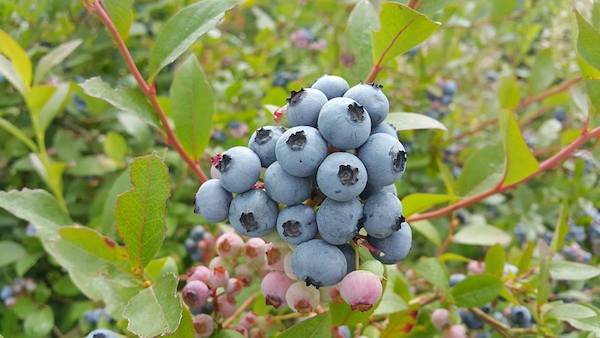
Blueberries are the queen of berry fruits as they have no thorns, they're not invasive, there's no need for support or spraying and you can grow them in any climate.
The essential requirement for growing blueberries successfully is an acidic soil of ph3-5. This is a low pH and will require additives to achieve. Increase the acidity of your soil by adding peat moss (blueberries' natural growing environment, although we prefer spaghnum moss as it's renewable), elemental sulphur (Flowers of Sulphur is also fine) and coffee grounds. We would also add compost and volcanic rock dust to the bed before planting to ensure the soil is alive and full of nutrients that the plants can take up.
Blueberries grow to about 180cms and you'll need to net them all year round as the birds eat the fruit buds in winter and spring, then ravage the fruit in summer. They're best grown in a bed of their own.
The two main types of blueberries grown in New Zealand are Highbush and Rabbiteyes. Rabbiteyes are more commonly sold in garden centres because they're evergreen and more attractive. The advantage of a deciduous variety like Highbush though is that if a plant gets diseased, it's more likely to shed the disease with the leaves.
Highbush blueberries are self-fertile but will pollinate better with more than one variety and you'll have bigger fruit and a longer harvest season as different varieties ripen at different times. Rabbiteyes are mostly self-sterile, so growing two or more varieties is important.
Blueberries need constantly moist growing conditions and also have shallow roots, so we recommend mulching. We use fresh pine needles as they're slightly acidic (pine needles lose their acidity as they age though). Well-rotted sawdust is acidic too and is a good mulch. But any mulch is better than no mulch.
If you plant 2-year-old blueberry bushes, they should start to bear within a year or two. In order to create good strong shrubs, you're best to remove the flowers for at least the first year. That way all the plant's energy goes into establishing itself, rather than fruit production. Full production is reached after about 6 years and blueberry shrubs last for up to 20 years.
There's no need to prune in the first four years until shrubs get up to their maximum height of around 180cms. But cut out any dead wood. From then on, pruning is needed to stimulate growth of the new shoots that will bear fruit the following season. Prune plants in early to mid-winter before new growth begins.
Blueberries will be ready for picking in December through March depending on the variety and your location. Don't rush to pick the berries as soon as they turn blue. Wait a couple of days and when they're ready, they should fall off into your hand.
-----
We collaborated with Mamaku Blue Blueberry Experience for this story. Their shop is located near Rotorua and they also sell at La Cigale French market, Parnell and Grey Lynn Farmers' Markets in Auckland in season and also online.
Organic Edible Garden's vision is to make organic edible gardening achievable for everyone. Visit their website for Getting Started videos, and web episodes each week to find out what to do for your edible garden.

